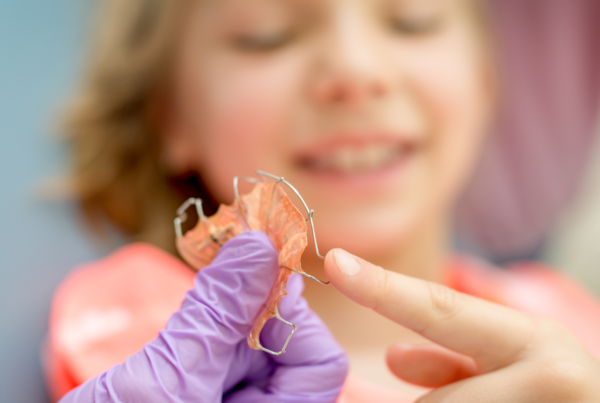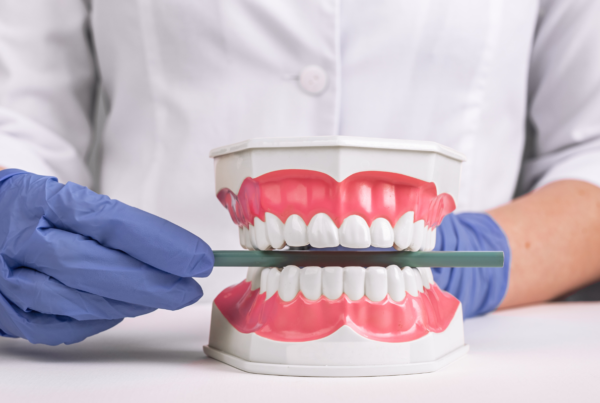- What is a scissor bite and how can it be treated?
- Scissor bite and deep bite – what do they have in common?
- Causes of a scissor bite
- Symptoms of a scissor bite
- Diagnosis of a scissor bite
- How is a scissor bite treated? Are braces enough?
- Summary: if you notice bite irregularities, see an orthodontist as soon as possible

A scissor bite is one of the bite irregularities that can affect both the aesthetics and functionality of the oral cavity. Although often underestimated, this condition can lead to serious health complications if not properly diagnosed and treated. Below, we explain what a scissor bite is, what causes it, how to recognize its symptoms, and how it is treated. Want to learn more about this malocclusion? Keep reading.
What is a scissor bite and how can it be treated?
A scissor bite is a type of malocclusion in which the upper teeth overlap the lower teeth in an abnormal way, causing contact outside the proper occlusal plane. As a result, the lower teeth can be completely covered by the upper ones, which affects both chewing function and facial aesthetics. Unlike open or crossbites, a scissor bite mainly affects the lateral segments of the dental arches. In short, it occurs when the premolars or molars protrude excessively outward. Common coexisting conditions include complete distocclusion with labial or lingual inclination of the upper incisors, as well as dental crowding.
Scissor bite and deep bite – what do they have in common?
A deep bite, like the scissor bite, belongs to the category of vertical malocclusions and is characterized by abnormal overlap of the upper teeth over the lower ones. Both conditions can lead to pressure on the periodontium and enamel wear. Treating a deep bite often requires fixed appliances such as the Ostrowski appliance, which lifts the posterior teeth to gradually reduce the overbite. The treatment of a scissor bite follows similar orthodontic principles, as explained below.
Causes of a scissor bite
Scissor bite results from a combination of genetic, environmental, and developmental factors. Understanding these mechanisms is crucial for prevention and effective treatment.
Genetic factors
Inherited traits such as disproportionate jaw growth or abnormal dental arch shapes can cause the upper jaw to extend beyond the lower one. Irregular spacing or crowding in the arch can also increase the likelihood of developing a scissor bite. If family members have had bite irregularities, the risk of inheritance is higher.
Environmental factors
- Several external influences during the growth phases of the jaw contribute to the development of a scissor bite.
- Prolonged thumb sucking or pacifier use can affect the natural development of the dental arches by placing excessive pressure on the upper teeth and palate.
- Mouth breathing due to chronic nasal obstruction changes the tongue and jaw position, encouraging bite issues.
- Chewing food on one side of the mouth can create asymmetry in jaw development, contributing to malocclusion.
Growth disorders of the maxilla and mandible
Improper jaw development due to trauma, poor posture, or nutritional deficiencies (e.g., calcium or vitamin D) can weaken the bone structure and disturb normal tooth positioning, which may result in scissor bite.
Developmental factors
Scissor bite may also be caused by abnormal tooth eruption, either too early or too late, which can lead to misalignment or crowding. Premature loss of primary teeth can cause neighboring teeth to shift, disrupting the dental arch.
Skeletal disorders and genetic syndromes like Pierre Robin sequence or Down syndrome may also contribute to malocclusion.
Social and educational factors
Low awareness among parents regarding oral health habits and the importance of regular dental check-ups can delay the diagnosis and treatment of bite problems, increasing the risk of complications.
READ MORE: How to clean a removable and fixed orthodontic appliance?
Symptoms of a scissor bite
Scissor bite symptoms vary depending on severity and age but should be identified early for effective treatment.
- Physical symptoms. One of the most noticeable signs is abnormal alignment of the upper and lower arches. The upper teeth move outward and cover the lower teeth. Patients may experience difficulties chewing, uneven bite pressure, speech issues due to misalignment, and pain when closing their jaws.
- Health symptoms. Misalignment causes uneven pressure on teeth, which leads to enamel wear, sensitivity, and increased risk of decay. The temporomandibular joints may be overloaded, causing pain or clicking during jaw movement. Gum recession may occur due to improper tooth positioning, and muscle tension can result in neck and head pain.
- Aesthetic symptoms. Facial asymmetry becomes more noticeable, especially in advanced cases. The smile may appear unnatural due to excessive overlap of the upper teeth. In severe scissor bites, the lower jaw appears significantly retracted compared to the upper jaw.
- Psychological symptoms. Visible bite irregularities may affect self-esteem and lead to social withdrawal. Patients may avoid smiling or speaking in public, reducing their quality of life.
Diagnosis of a scissor bite
Diagnosis begins with a clinical examination by a dentist or orthodontist. The specialist assesses dental alignment, occlusion, facial symmetry, and jaw movement. Additional imaging, such as panoramic X-rays or CT scans, helps evaluate the bone structure and tooth roots. Intraoral digital scans create accurate 3D models for treatment planning.
Patient interviews are also essential. The specialist asks about pain, chewing or speech difficulties, and daily challenges. In children, habits such as thumb sucking or mouth breathing are assessed.
Early diagnosis is crucial, especially in children, as it enables less invasive treatment and prevents further complications. Modern diagnostics allow precise identification and targeted therapy.
How is a scissor bite treated? Are braces enough?
Treatment depends on the severity of the malocclusion, the patient’s age, and overall oral health. Orthodontic treatment is the foundation. Fixed metal or ceramic braces are effective in shifting the teeth into the correct position. Clear aligners are a popular alternative for adults, offering comfort and aesthetics. In children and adolescents, palatal expanders are used to widen the upper arch.
Myofunctional therapy plays an important role, especially in young patients, by strengthening oral muscles and improving chewing function.
In severe cases, surgical intervention may be necessary. Orthognathic surgery realigns the jaws, restoring bite balance and facial proportions. Tooth extractions may also be performed to create space for proper alignment.
Scissor bite treatment often involves an interdisciplinary team. Speech therapists help correct habits and improve articulation, while physiotherapists address muscle tension and joint function.
Early intervention is essential, especially during jaw development. Regular check-ups and cooperation with specialists are key to achieving a healthy and functional smile. Treatment duration can range from several months to two years, depending on individual factors.
Summary: if you notice bite irregularities, see an orthodontist as soon as possible
A scissor bite is a serious malocclusion that can impact health, appearance, and comfort. With modern diagnostics and treatment methods, this condition can be effectively managed. Early intervention prevents complications and improves long-term outcomes. Now you know how to recognize a scissor bite and what treatment options are available, including orthodontic solutions. If you or your child experience symptoms, consult a specialist for a tailored treatment plan. Remember, a healthy smile is a lifelong investment.





